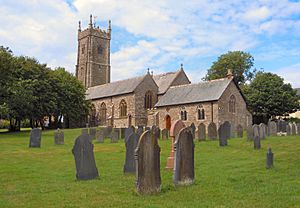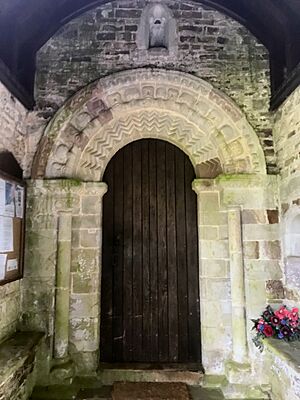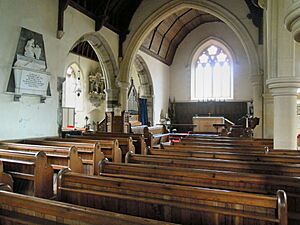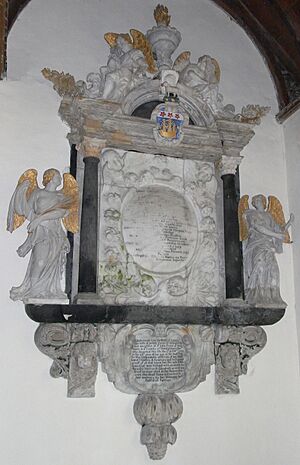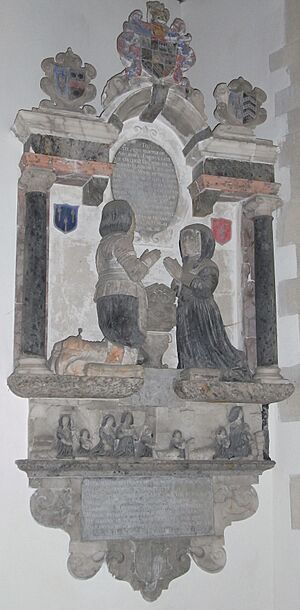Church of St Mary and St Benedict, Buckland Brewer facts for kids
St Mary and St Benedict is an old church in the village of Buckland Brewer, North Devon. It's a Church of England parish church, which means it serves the local community. It's part of a group of churches in the area.
This church started being built in the 1300s. It has parts from an even older church from around the year 1100! It was fixed up a lot in the 1800s. Today, it's a special building protected by Historic England, called a Grade II* listed building. This means it's very important and needs to be preserved.
Contents
A Look at the Church's Past
The church you see today is actually the third one built on this spot. The very first church was probably built around the year 1100. We know that the first priest recorded here was Sir Walter de Denetone, who started in 1279.
The first church burned down around 1390. But a special part survived: a beautiful, carved doorway from the Norman times. This old doorway is still the main entrance to the church on the south side.
The church was rebuilt around 1399. For a long time, a monastery called Torre Abbey owned the church. But in 1539, King Henry VIII took control of it. Since then, the ruling king or queen has chosen the church's priest.
In 1769, lightning struck the church, and it almost burned down again! You can still see fire damage on some pillars inside. Later, in 1877, big storms hit the church. This led to a lot of repair work between 1878 and 1880.
What the Church Looks Like Inside and Out
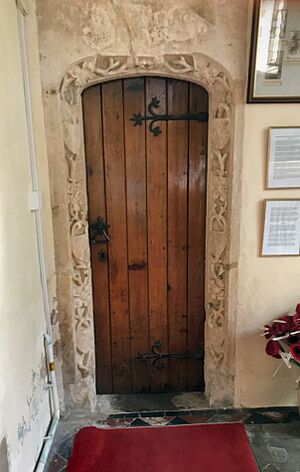
The church building, started around 1399, is made of flat, layered stones. The main part of the church, called the nave, and the chancel (the area around the altar) were greatly restored in the late 1800s. This work was done by an architect named Samuel Hooper.
Next to the chancel is the north chapel, also known as the "Orleigh Chapel." This is one of the oldest parts of the church, along with the tower. It has some interesting stone monuments on its walls.
There's a special stone door from the 1500s called the priest's door. It's carved with leaves and shields. Some parts of it were damaged on purpose during the English Civil War. This door leads to a passage that connects to an old schoolroom. This room was once a parish school and might have been a chapel. It was fixed up in 1880 and is now used as a church hall.
Most of the church's windows were added during the Victorian restoration in the late 1800s.
Inside the chancel, you'll find two basins called piscinae, used for washing sacred vessels. One of them has a piece from the 1300s. The decorated screen behind the altar, called a reredos, is from the late Victorian period. The wooden roofs of the chancel and nave are also from this time.
The chancel has arches leading to the Orleigh Chapel, which date back to the 1300s. The main arch leading to the chancel is from the 1800s. The nave has a row of arches on its south side from the 1400s.
You'll also see 1800s choir stalls, benches, a pulpit (where sermons are given), and a lectern (for reading lessons). The pulpit has eight old oak panels from an even older pulpit. The unique, urn-shaped font, used for baptisms, was carved from local stone in 1771.
The south side of the church has five sections with windows. The gabled porch at the entrance is from the 1400s. Above the doorway, there's a sundial from the 1700s. Inside the porch, to the right, you can find a stoup (a basin for holy water) from the 1300s. Above the main Norman doorway, there's a small niche for a statue, dating to about 1200. This doorway is decorated with special carvings of beakheads and chevron patterns.
The church's tall tower on the west side is 76 feet high. Both the tower and its large window are from the 1400s. The church has six bells. They were remade in the village in 1825 and again in 1899 by a company called John Taylor & Co from Loughborough. The founder of this company was born in Buckland Brewer, and there's a brass plaque in the church to remember him.
The Churchyard: A Quiet Resting Place
The churchyard is the burial ground for people from the village. It has been used by Anglicans and Methodists for many years. You can find three graves from World War II here, marked with special headstones from the Commonwealth War Graves Commission.
Special Memorials Inside the Church
In the Orleigh Chapel, there's a fancy wall monument for John Davie (1640-1710). He was an important person in Bideford and helped with statements during the Bideford witch trial in 1682. The monument also remembers his wife, Mary, and their daughter-in-law, Juliana Davie, who died in 1720. John Davie bought a large house called Orleigh Court in Buckland Brewer in 1684.
Nearby is another wall monument for Anthony Dennis (died 1641) and his second wife, Gertrude. It has figures of their eleven children below them. Eight children are kneeling, and three are lying down, showing they died when they were very young. This monument was put up in 1643.
Between these two monuments is a unique memorial for Phillip Vening. He was only six years old when he died in 1658. The memorial shows him leaning his head on his hand, with his elbow resting on a skull. It's made of colored marble with black slate.
There are also other memorials, including one for John Taylor (1827-1906), the famous bellfounder from Loughborough, who was born in the village. In the south aisle, there's a stone tablet for William Radford Caddy, a young naval officer who drowned in 1823 while trying to save a friend. Above it is another memorial for his father, John Caddy. In the church's south-east corner, there are memorials to the men from the village who died during World War I and World War II.
Gallery


